Wound Assessment and Management
VerifiedAdded on 2023/01/20
|10
|2707
|60
AI Summary
This assignment discusses wound assessment and management for two different patients, including goals of therapy, characteristics of wound management regimen, and rationale for dressing selection.
Contribute Materials
Your contribution can guide someone’s learning journey. Share your
documents today.
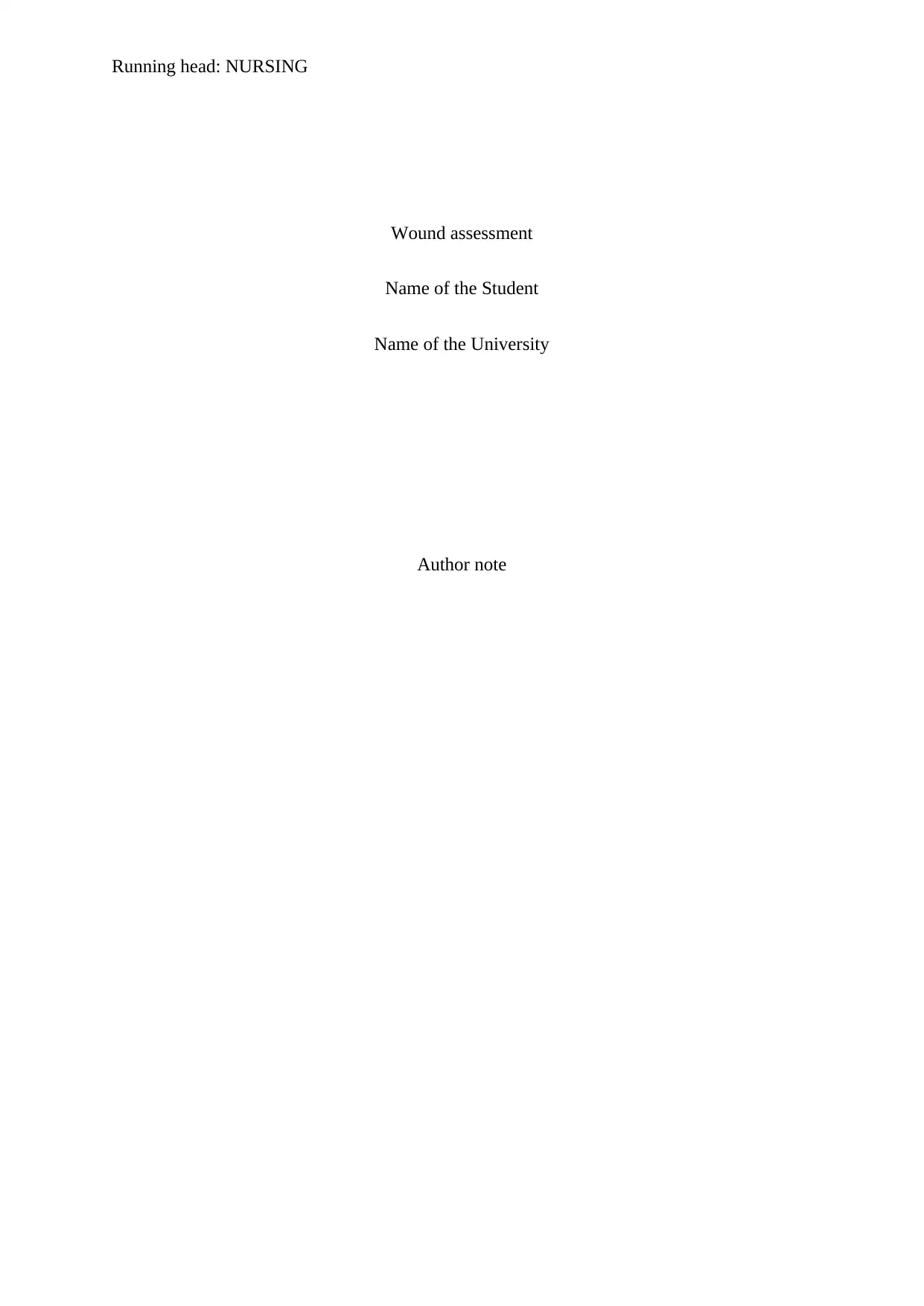
Running head: NURSING
Wound assessment
Name of the Student
Name of the University
Author note
Wound assessment
Name of the Student
Name of the University
Author note
Secure Best Marks with AI Grader
Need help grading? Try our AI Grader for instant feedback on your assignments.
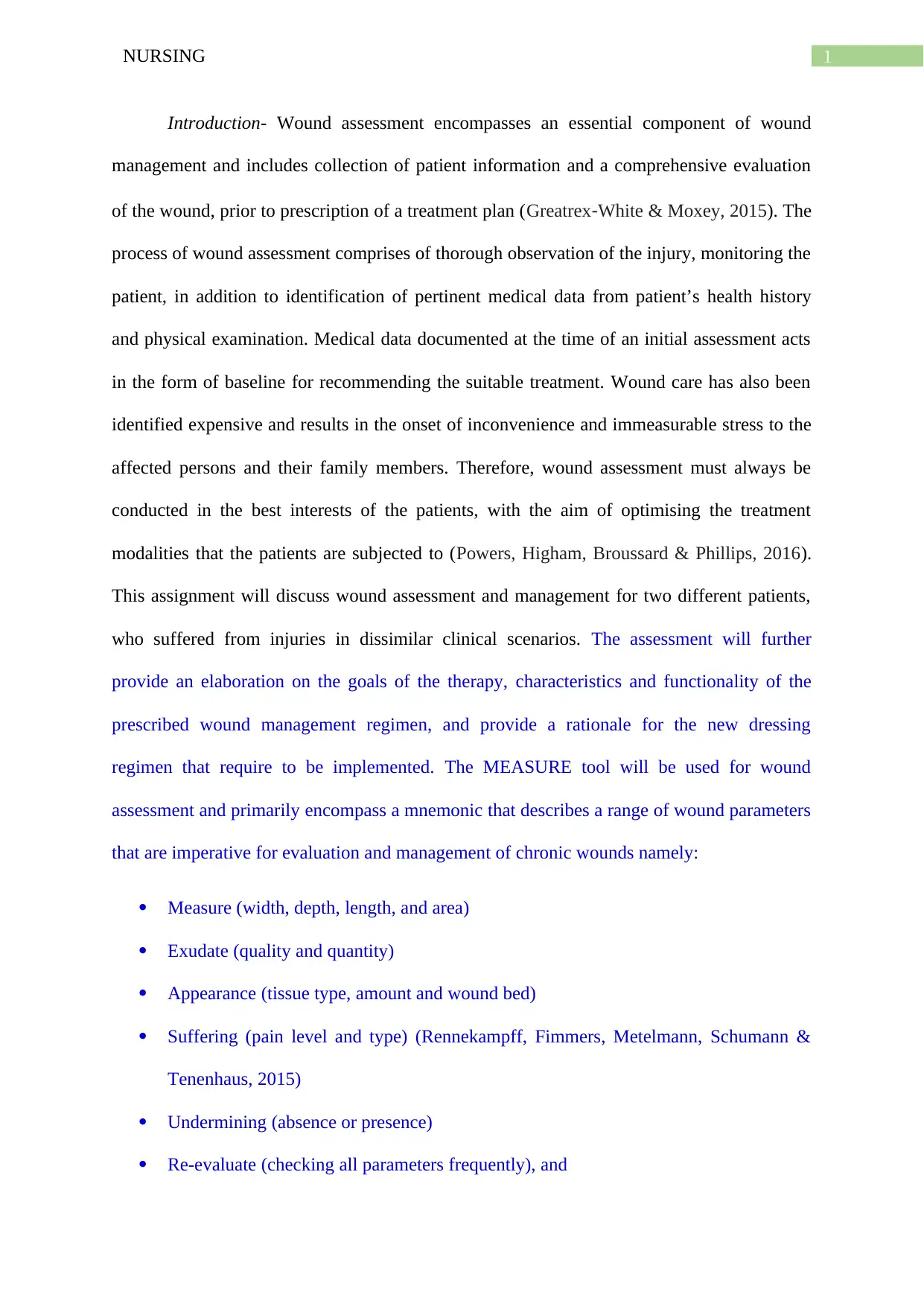
1NURSING
Introduction- Wound assessment encompasses an essential component of wound
management and includes collection of patient information and a comprehensive evaluation
of the wound, prior to prescription of a treatment plan (Greatrex‐White & Moxey, 2015). The
process of wound assessment comprises of thorough observation of the injury, monitoring the
patient, in addition to identification of pertinent medical data from patient’s health history
and physical examination. Medical data documented at the time of an initial assessment acts
in the form of baseline for recommending the suitable treatment. Wound care has also been
identified expensive and results in the onset of inconvenience and immeasurable stress to the
affected persons and their family members. Therefore, wound assessment must always be
conducted in the best interests of the patients, with the aim of optimising the treatment
modalities that the patients are subjected to (Powers, Higham, Broussard & Phillips, 2016).
This assignment will discuss wound assessment and management for two different patients,
who suffered from injuries in dissimilar clinical scenarios. The assessment will further
provide an elaboration on the goals of the therapy, characteristics and functionality of the
prescribed wound management regimen, and provide a rationale for the new dressing
regimen that require to be implemented. The MEASURE tool will be used for wound
assessment and primarily encompass a mnemonic that describes a range of wound parameters
that are imperative for evaluation and management of chronic wounds namely:
Measure (width, depth, length, and area)
Exudate (quality and quantity)
Appearance (tissue type, amount and wound bed)
Suffering (pain level and type) (Rennekampff, Fimmers, Metelmann, Schumann &
Tenenhaus, 2015)
Undermining (absence or presence)
Re-evaluate (checking all parameters frequently), and
Introduction- Wound assessment encompasses an essential component of wound
management and includes collection of patient information and a comprehensive evaluation
of the wound, prior to prescription of a treatment plan (Greatrex‐White & Moxey, 2015). The
process of wound assessment comprises of thorough observation of the injury, monitoring the
patient, in addition to identification of pertinent medical data from patient’s health history
and physical examination. Medical data documented at the time of an initial assessment acts
in the form of baseline for recommending the suitable treatment. Wound care has also been
identified expensive and results in the onset of inconvenience and immeasurable stress to the
affected persons and their family members. Therefore, wound assessment must always be
conducted in the best interests of the patients, with the aim of optimising the treatment
modalities that the patients are subjected to (Powers, Higham, Broussard & Phillips, 2016).
This assignment will discuss wound assessment and management for two different patients,
who suffered from injuries in dissimilar clinical scenarios. The assessment will further
provide an elaboration on the goals of the therapy, characteristics and functionality of the
prescribed wound management regimen, and provide a rationale for the new dressing
regimen that require to be implemented. The MEASURE tool will be used for wound
assessment and primarily encompass a mnemonic that describes a range of wound parameters
that are imperative for evaluation and management of chronic wounds namely:
Measure (width, depth, length, and area)
Exudate (quality and quantity)
Appearance (tissue type, amount and wound bed)
Suffering (pain level and type) (Rennekampff, Fimmers, Metelmann, Schumann &
Tenenhaus, 2015)
Undermining (absence or presence)
Re-evaluate (checking all parameters frequently), and
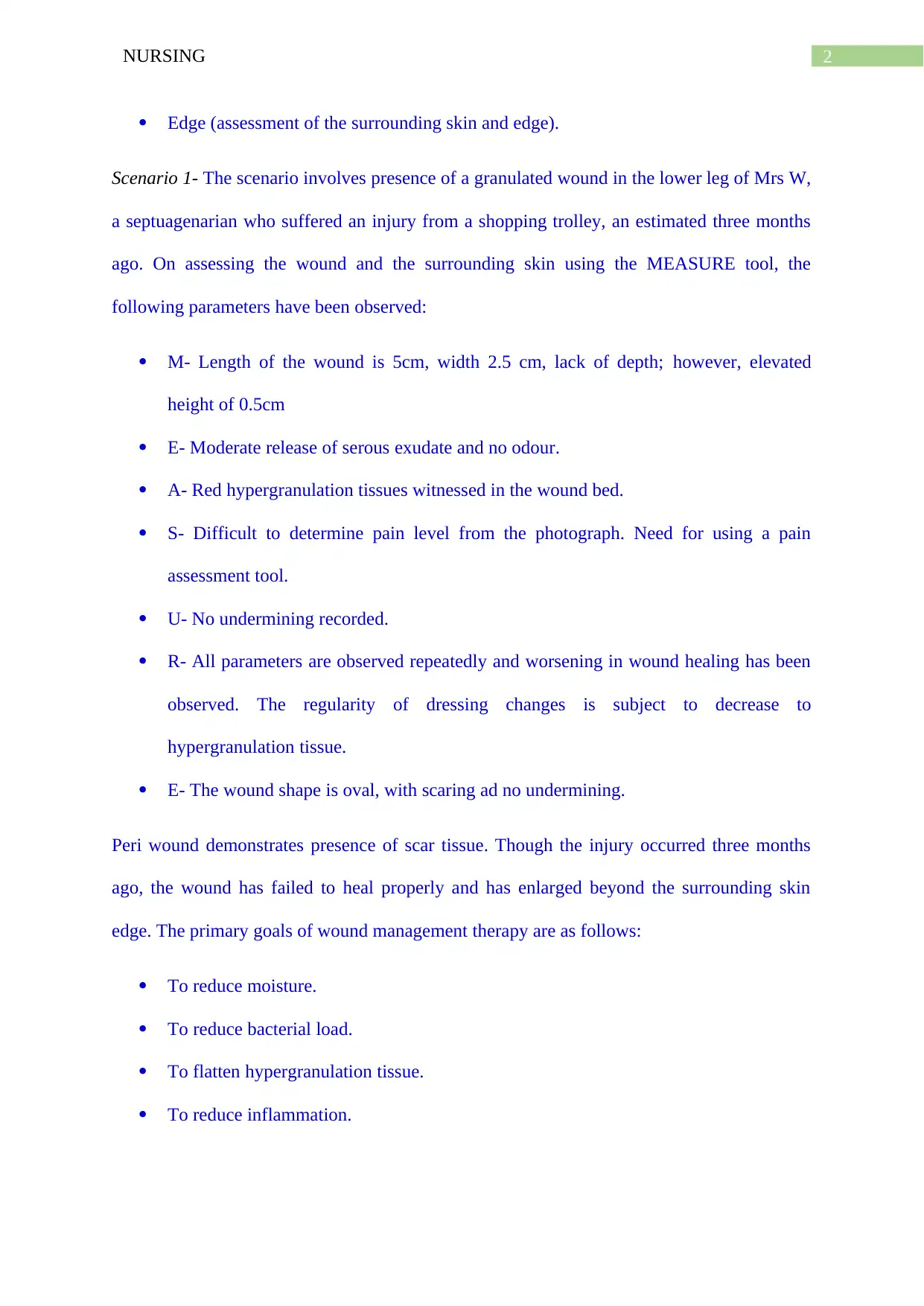
2NURSING
Edge (assessment of the surrounding skin and edge).
Scenario 1- The scenario involves presence of a granulated wound in the lower leg of Mrs W,
a septuagenarian who suffered an injury from a shopping trolley, an estimated three months
ago. On assessing the wound and the surrounding skin using the MEASURE tool, the
following parameters have been observed:
M- Length of the wound is 5cm, width 2.5 cm, lack of depth; however, elevated
height of 0.5cm
E- Moderate release of serous exudate and no odour.
A- Red hypergranulation tissues witnessed in the wound bed.
S- Difficult to determine pain level from the photograph. Need for using a pain
assessment tool.
U- No undermining recorded.
R- All parameters are observed repeatedly and worsening in wound healing has been
observed. The regularity of dressing changes is subject to decrease to
hypergranulation tissue.
E- The wound shape is oval, with scaring ad no undermining.
Peri wound demonstrates presence of scar tissue. Though the injury occurred three months
ago, the wound has failed to heal properly and has enlarged beyond the surrounding skin
edge. The primary goals of wound management therapy are as follows:
To reduce moisture.
To reduce bacterial load.
To flatten hypergranulation tissue.
To reduce inflammation.
Edge (assessment of the surrounding skin and edge).
Scenario 1- The scenario involves presence of a granulated wound in the lower leg of Mrs W,
a septuagenarian who suffered an injury from a shopping trolley, an estimated three months
ago. On assessing the wound and the surrounding skin using the MEASURE tool, the
following parameters have been observed:
M- Length of the wound is 5cm, width 2.5 cm, lack of depth; however, elevated
height of 0.5cm
E- Moderate release of serous exudate and no odour.
A- Red hypergranulation tissues witnessed in the wound bed.
S- Difficult to determine pain level from the photograph. Need for using a pain
assessment tool.
U- No undermining recorded.
R- All parameters are observed repeatedly and worsening in wound healing has been
observed. The regularity of dressing changes is subject to decrease to
hypergranulation tissue.
E- The wound shape is oval, with scaring ad no undermining.
Peri wound demonstrates presence of scar tissue. Though the injury occurred three months
ago, the wound has failed to heal properly and has enlarged beyond the surrounding skin
edge. The primary goals of wound management therapy are as follows:
To reduce moisture.
To reduce bacterial load.
To flatten hypergranulation tissue.
To reduce inflammation.
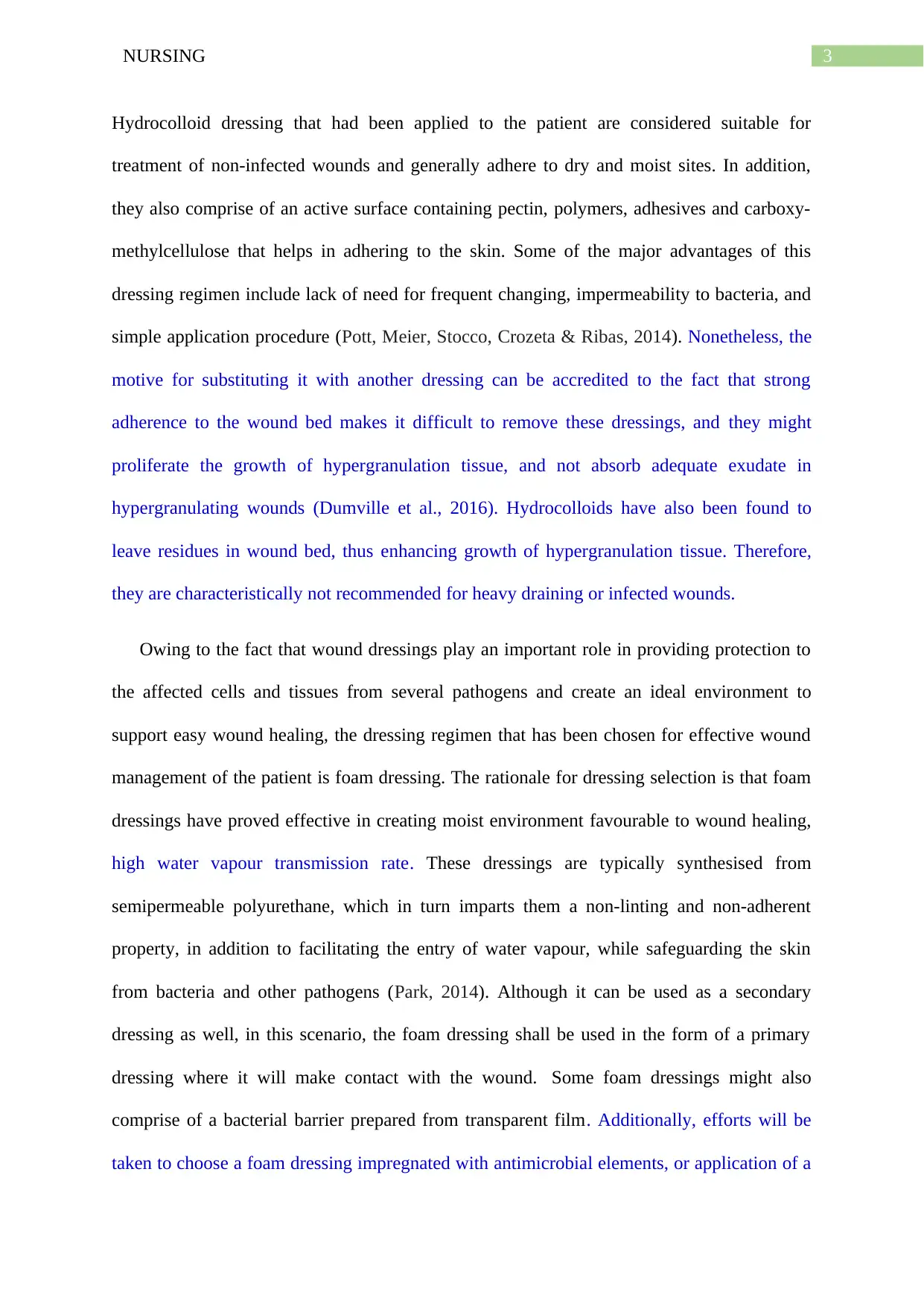
3NURSING
Hydrocolloid dressing that had been applied to the patient are considered suitable for
treatment of non-infected wounds and generally adhere to dry and moist sites. In addition,
they also comprise of an active surface containing pectin, polymers, adhesives and carboxy-
methylcellulose that helps in adhering to the skin. Some of the major advantages of this
dressing regimen include lack of need for frequent changing, impermeability to bacteria, and
simple application procedure (Pott, Meier, Stocco, Crozeta & Ribas, 2014). Nonetheless, the
motive for substituting it with another dressing can be accredited to the fact that strong
adherence to the wound bed makes it difficult to remove these dressings, and they might
proliferate the growth of hypergranulation tissue, and not absorb adequate exudate in
hypergranulating wounds (Dumville et al., 2016). Hydrocolloids have also been found to
leave residues in wound bed, thus enhancing growth of hypergranulation tissue. Therefore,
they are characteristically not recommended for heavy draining or infected wounds.
Owing to the fact that wound dressings play an important role in providing protection to
the affected cells and tissues from several pathogens and create an ideal environment to
support easy wound healing, the dressing regimen that has been chosen for effective wound
management of the patient is foam dressing. The rationale for dressing selection is that foam
dressings have proved effective in creating moist environment favourable to wound healing,
high water vapour transmission rate. These dressings are typically synthesised from
semipermeable polyurethane, which in turn imparts them a non-linting and non-adherent
property, in addition to facilitating the entry of water vapour, while safeguarding the skin
from bacteria and other pathogens (Park, 2014). Although it can be used as a secondary
dressing as well, in this scenario, the foam dressing shall be used in the form of a primary
dressing where it will make contact with the wound. Some foam dressings might also
comprise of a bacterial barrier prepared from transparent film. Additionally, efforts will be
taken to choose a foam dressing impregnated with antimicrobial elements, or application of a
Hydrocolloid dressing that had been applied to the patient are considered suitable for
treatment of non-infected wounds and generally adhere to dry and moist sites. In addition,
they also comprise of an active surface containing pectin, polymers, adhesives and carboxy-
methylcellulose that helps in adhering to the skin. Some of the major advantages of this
dressing regimen include lack of need for frequent changing, impermeability to bacteria, and
simple application procedure (Pott, Meier, Stocco, Crozeta & Ribas, 2014). Nonetheless, the
motive for substituting it with another dressing can be accredited to the fact that strong
adherence to the wound bed makes it difficult to remove these dressings, and they might
proliferate the growth of hypergranulation tissue, and not absorb adequate exudate in
hypergranulating wounds (Dumville et al., 2016). Hydrocolloids have also been found to
leave residues in wound bed, thus enhancing growth of hypergranulation tissue. Therefore,
they are characteristically not recommended for heavy draining or infected wounds.
Owing to the fact that wound dressings play an important role in providing protection to
the affected cells and tissues from several pathogens and create an ideal environment to
support easy wound healing, the dressing regimen that has been chosen for effective wound
management of the patient is foam dressing. The rationale for dressing selection is that foam
dressings have proved effective in creating moist environment favourable to wound healing,
high water vapour transmission rate. These dressings are typically synthesised from
semipermeable polyurethane, which in turn imparts them a non-linting and non-adherent
property, in addition to facilitating the entry of water vapour, while safeguarding the skin
from bacteria and other pathogens (Park, 2014). Although it can be used as a secondary
dressing as well, in this scenario, the foam dressing shall be used in the form of a primary
dressing where it will make contact with the wound. Some foam dressings might also
comprise of a bacterial barrier prepared from transparent film. Additionally, efforts will be
taken to choose a foam dressing impregnated with antimicrobial elements, or application of a
Secure Best Marks with AI Grader
Need help grading? Try our AI Grader for instant feedback on your assignments.

4NURSING
secondary dressing used with such as, silver or surfactants, which in turn would act as
vehicles for the transfer of the antimicrobials to the wound bed, to enhance wound healing
(Lee et al., 2016). Some major advantages of the dressing include lack of adherence to the
wound site, acting in the form of cushion for protecting the affected site, providing a barrier
against pathogens, and easy application and removal (Liu, Niu, Chen & Chen, 2017).
Scenario 3- The third scenario involves an Mrs Z, an octogenarian who sustained a
category three skin tear category six weeks earlier, in her lower leg, during her stay in a
hospital for an unrelated health ailment. On assessing the wound and the surrounding skin
using the MEASURE tool, the following parameters have been observed:
M- Two island of wounds divided by a healed tissue region. The measurements of the
largest wound include width 1cm, length 1cm, and absence of depth. Measurements
of the smallest wound include width 0.5cm, length 0.5cm, and no depth.
E- Moderate/ minimal exudate release, with occasional bleeding, without any odour.
A- Presence of a large wound that has healed, but with two smaller island wounds.
The large wound shows approximately 50% yellow slough. In contrast, the smaller
wound shows 80% bright yellow tissue.
S- Difficult to determine pain level from the photograph. Need for using a pain
assessment tool.
U- No undermining observed.
R- Frequent checking of all parameters on a consistent basis.
E- No definite shape, with epithelial light pink tissues on the wound edges. The
surrounding skin is slightly macerated from the contact, with moisture or exudate.
Dead skin tissues surround the wound.
The primary goals of the wound management therapy are given below:
secondary dressing used with such as, silver or surfactants, which in turn would act as
vehicles for the transfer of the antimicrobials to the wound bed, to enhance wound healing
(Lee et al., 2016). Some major advantages of the dressing include lack of adherence to the
wound site, acting in the form of cushion for protecting the affected site, providing a barrier
against pathogens, and easy application and removal (Liu, Niu, Chen & Chen, 2017).
Scenario 3- The third scenario involves an Mrs Z, an octogenarian who sustained a
category three skin tear category six weeks earlier, in her lower leg, during her stay in a
hospital for an unrelated health ailment. On assessing the wound and the surrounding skin
using the MEASURE tool, the following parameters have been observed:
M- Two island of wounds divided by a healed tissue region. The measurements of the
largest wound include width 1cm, length 1cm, and absence of depth. Measurements
of the smallest wound include width 0.5cm, length 0.5cm, and no depth.
E- Moderate/ minimal exudate release, with occasional bleeding, without any odour.
A- Presence of a large wound that has healed, but with two smaller island wounds.
The large wound shows approximately 50% yellow slough. In contrast, the smaller
wound shows 80% bright yellow tissue.
S- Difficult to determine pain level from the photograph. Need for using a pain
assessment tool.
U- No undermining observed.
R- Frequent checking of all parameters on a consistent basis.
E- No definite shape, with epithelial light pink tissues on the wound edges. The
surrounding skin is slightly macerated from the contact, with moisture or exudate.
Dead skin tissues surround the wound.
The primary goals of the wound management therapy are given below:

5NURSING
To reduce moisture.
To reduce bacterial load.
To remove dead tissue, slough.
To prevent dressing from sticking to wound.
To promote wound healing.
Low-adherent pad dressings are typically used for wound management, with the aim of
absorbing excess exudates or fluids from the wound, besides providing an appropriate
physical barrier to any form of infection. In addition, administration of these dressings to the
patient also helped in putting a limitation on the destruction of new tissues, upon removal of
the dressings. Owing to their wide availability and low costs, these dressings are considered
suitable for allowing exudates to pass thorough, and reach a secondary dressing, while a
moist wound bed is maintained (Asghari, Logsetty & Liu, 2016). However, the primary
reason for replacing this dressing can be accredited to the fact that this dressing has been
found to stick to the wound, which increases the risks for necrosis or ischemia, and will
reduce the healing rate by promoting infection.
Taking into consideration the fact that the wound bleeds occasionally, application of
application of foam dressing containing silver has been considered suitable for the scenario.
These dressings are found to be soft and conformable, created from polyurethane. They
typically comprise of a complex of ionic silver that remains dispersed in a homogenous
manner throughout the matrix of the foam (Senet, Bause, Jørgensen & Fogh, 2014). In
addition, the dressing also comprises of a waterproof, semipermeable and bacteria proof film
on the top that prevents invasion of the wound site by pathogens. The antibacterial
characteristics of sliver have been recognised all across the world and foam dressing
impregnated with silver facilitates reducing the count of wound bacteria (Nolff et al., 2015).
In addition, these dressings will also provide a moist wound environment at the site of
To reduce moisture.
To reduce bacterial load.
To remove dead tissue, slough.
To prevent dressing from sticking to wound.
To promote wound healing.
Low-adherent pad dressings are typically used for wound management, with the aim of
absorbing excess exudates or fluids from the wound, besides providing an appropriate
physical barrier to any form of infection. In addition, administration of these dressings to the
patient also helped in putting a limitation on the destruction of new tissues, upon removal of
the dressings. Owing to their wide availability and low costs, these dressings are considered
suitable for allowing exudates to pass thorough, and reach a secondary dressing, while a
moist wound bed is maintained (Asghari, Logsetty & Liu, 2016). However, the primary
reason for replacing this dressing can be accredited to the fact that this dressing has been
found to stick to the wound, which increases the risks for necrosis or ischemia, and will
reduce the healing rate by promoting infection.
Taking into consideration the fact that the wound bleeds occasionally, application of
application of foam dressing containing silver has been considered suitable for the scenario.
These dressings are found to be soft and conformable, created from polyurethane. They
typically comprise of a complex of ionic silver that remains dispersed in a homogenous
manner throughout the matrix of the foam (Senet, Bause, Jørgensen & Fogh, 2014). In
addition, the dressing also comprises of a waterproof, semipermeable and bacteria proof film
on the top that prevents invasion of the wound site by pathogens. The antibacterial
characteristics of sliver have been recognised all across the world and foam dressing
impregnated with silver facilitates reducing the count of wound bacteria (Nolff et al., 2015).
In addition, these dressings will also provide a moist wound environment at the site of
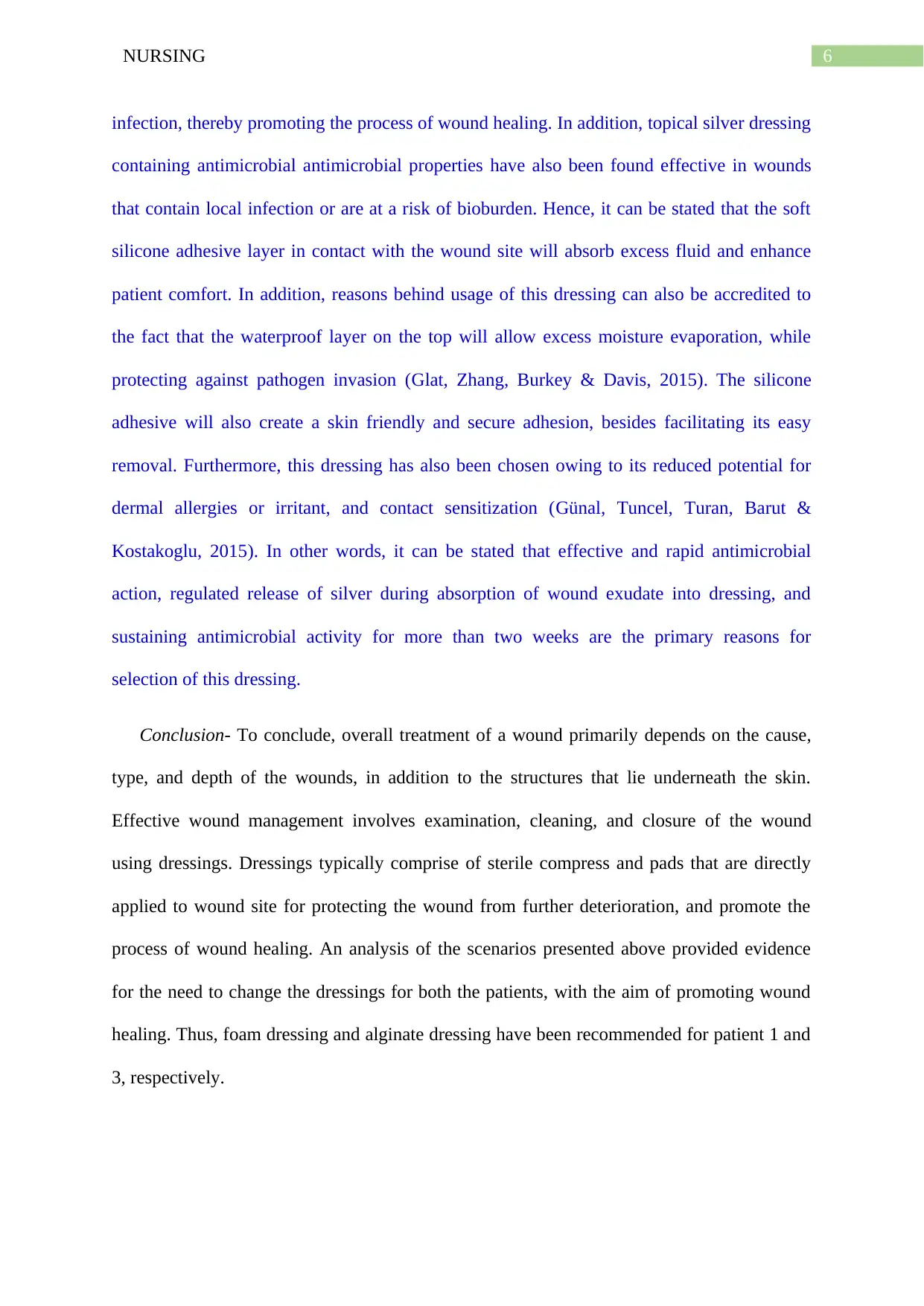
6NURSING
infection, thereby promoting the process of wound healing. In addition, topical silver dressing
containing antimicrobial antimicrobial properties have also been found effective in wounds
that contain local infection or are at a risk of bioburden. Hence, it can be stated that the soft
silicone adhesive layer in contact with the wound site will absorb excess fluid and enhance
patient comfort. In addition, reasons behind usage of this dressing can also be accredited to
the fact that the waterproof layer on the top will allow excess moisture evaporation, while
protecting against pathogen invasion (Glat, Zhang, Burkey & Davis, 2015). The silicone
adhesive will also create a skin friendly and secure adhesion, besides facilitating its easy
removal. Furthermore, this dressing has also been chosen owing to its reduced potential for
dermal allergies or irritant, and contact sensitization (Günal, Tuncel, Turan, Barut &
Kostakoglu, 2015). In other words, it can be stated that effective and rapid antimicrobial
action, regulated release of silver during absorption of wound exudate into dressing, and
sustaining antimicrobial activity for more than two weeks are the primary reasons for
selection of this dressing.
Conclusion- To conclude, overall treatment of a wound primarily depends on the cause,
type, and depth of the wounds, in addition to the structures that lie underneath the skin.
Effective wound management involves examination, cleaning, and closure of the wound
using dressings. Dressings typically comprise of sterile compress and pads that are directly
applied to wound site for protecting the wound from further deterioration, and promote the
process of wound healing. An analysis of the scenarios presented above provided evidence
for the need to change the dressings for both the patients, with the aim of promoting wound
healing. Thus, foam dressing and alginate dressing have been recommended for patient 1 and
3, respectively.
infection, thereby promoting the process of wound healing. In addition, topical silver dressing
containing antimicrobial antimicrobial properties have also been found effective in wounds
that contain local infection or are at a risk of bioburden. Hence, it can be stated that the soft
silicone adhesive layer in contact with the wound site will absorb excess fluid and enhance
patient comfort. In addition, reasons behind usage of this dressing can also be accredited to
the fact that the waterproof layer on the top will allow excess moisture evaporation, while
protecting against pathogen invasion (Glat, Zhang, Burkey & Davis, 2015). The silicone
adhesive will also create a skin friendly and secure adhesion, besides facilitating its easy
removal. Furthermore, this dressing has also been chosen owing to its reduced potential for
dermal allergies or irritant, and contact sensitization (Günal, Tuncel, Turan, Barut &
Kostakoglu, 2015). In other words, it can be stated that effective and rapid antimicrobial
action, regulated release of silver during absorption of wound exudate into dressing, and
sustaining antimicrobial activity for more than two weeks are the primary reasons for
selection of this dressing.
Conclusion- To conclude, overall treatment of a wound primarily depends on the cause,
type, and depth of the wounds, in addition to the structures that lie underneath the skin.
Effective wound management involves examination, cleaning, and closure of the wound
using dressings. Dressings typically comprise of sterile compress and pads that are directly
applied to wound site for protecting the wound from further deterioration, and promote the
process of wound healing. An analysis of the scenarios presented above provided evidence
for the need to change the dressings for both the patients, with the aim of promoting wound
healing. Thus, foam dressing and alginate dressing have been recommended for patient 1 and
3, respectively.
Paraphrase This Document
Need a fresh take? Get an instant paraphrase of this document with our AI Paraphraser
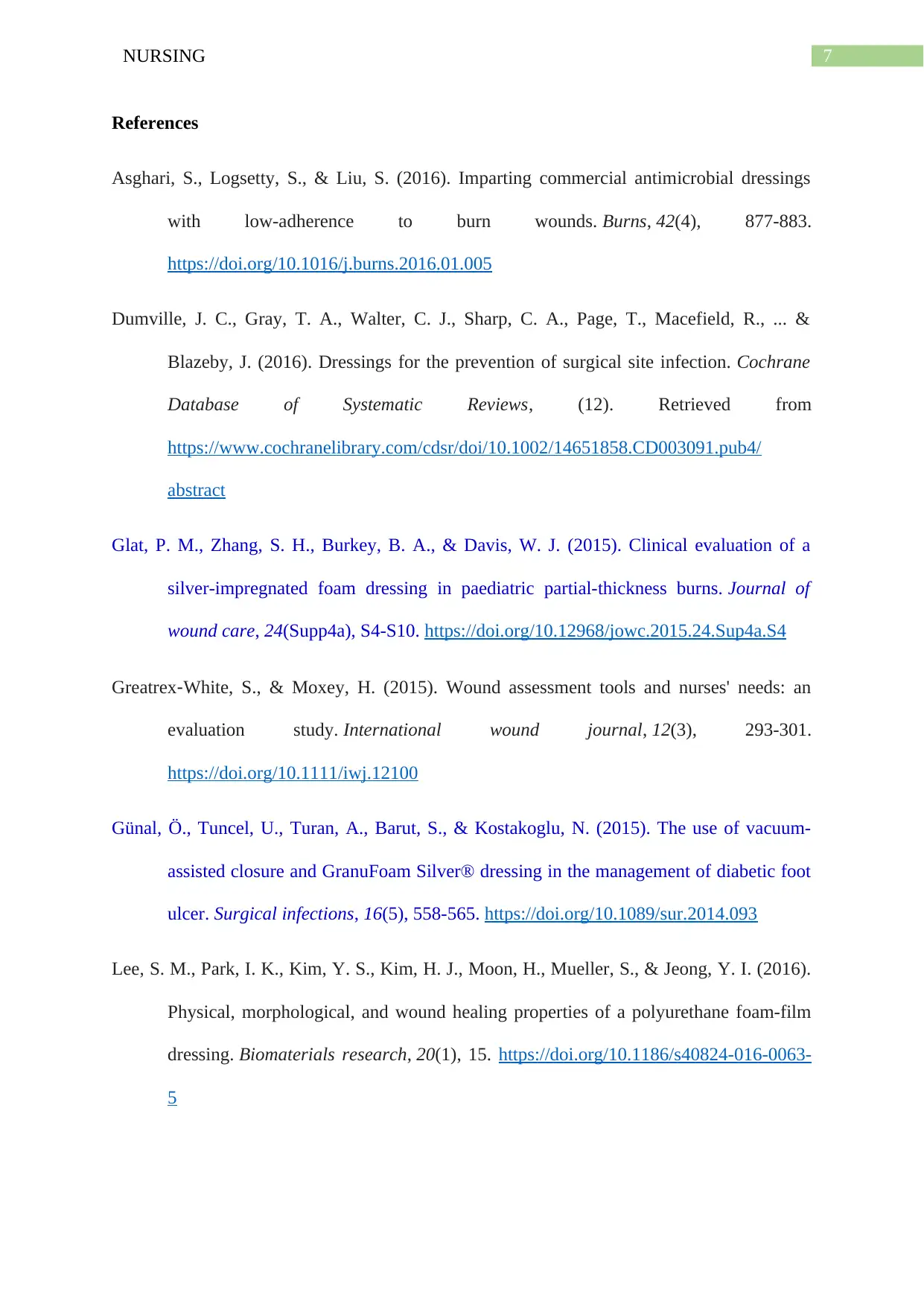
7NURSING
References
Asghari, S., Logsetty, S., & Liu, S. (2016). Imparting commercial antimicrobial dressings
with low-adherence to burn wounds. Burns, 42(4), 877-883.
https://doi.org/10.1016/j.burns.2016.01.005
Dumville, J. C., Gray, T. A., Walter, C. J., Sharp, C. A., Page, T., Macefield, R., ... &
Blazeby, J. (2016). Dressings for the prevention of surgical site infection. Cochrane
Database of Systematic Reviews, (12). Retrieved from
https://www.cochranelibrary.com/cdsr/doi/10.1002/14651858.CD003091.pub4/
abstract
Glat, P. M., Zhang, S. H., Burkey, B. A., & Davis, W. J. (2015). Clinical evaluation of a
silver-impregnated foam dressing in paediatric partial-thickness burns. Journal of
wound care, 24(Supp4a), S4-S10. https://doi.org/10.12968/jowc.2015.24.Sup4a.S4
Greatrex‐White, S., & Moxey, H. (2015). Wound assessment tools and nurses' needs: an
evaluation study. International wound journal, 12(3), 293-301.
https://doi.org/10.1111/iwj.12100
Günal, Ö., Tuncel, U., Turan, A., Barut, S., & Kostakoglu, N. (2015). The use of vacuum-
assisted closure and GranuFoam Silver® dressing in the management of diabetic foot
ulcer. Surgical infections, 16(5), 558-565. https://doi.org/10.1089/sur.2014.093
Lee, S. M., Park, I. K., Kim, Y. S., Kim, H. J., Moon, H., Mueller, S., & Jeong, Y. I. (2016).
Physical, morphological, and wound healing properties of a polyurethane foam-film
dressing. Biomaterials research, 20(1), 15. https://doi.org/10.1186/s40824-016-0063-
5
References
Asghari, S., Logsetty, S., & Liu, S. (2016). Imparting commercial antimicrobial dressings
with low-adherence to burn wounds. Burns, 42(4), 877-883.
https://doi.org/10.1016/j.burns.2016.01.005
Dumville, J. C., Gray, T. A., Walter, C. J., Sharp, C. A., Page, T., Macefield, R., ... &
Blazeby, J. (2016). Dressings for the prevention of surgical site infection. Cochrane
Database of Systematic Reviews, (12). Retrieved from
https://www.cochranelibrary.com/cdsr/doi/10.1002/14651858.CD003091.pub4/
abstract
Glat, P. M., Zhang, S. H., Burkey, B. A., & Davis, W. J. (2015). Clinical evaluation of a
silver-impregnated foam dressing in paediatric partial-thickness burns. Journal of
wound care, 24(Supp4a), S4-S10. https://doi.org/10.12968/jowc.2015.24.Sup4a.S4
Greatrex‐White, S., & Moxey, H. (2015). Wound assessment tools and nurses' needs: an
evaluation study. International wound journal, 12(3), 293-301.
https://doi.org/10.1111/iwj.12100
Günal, Ö., Tuncel, U., Turan, A., Barut, S., & Kostakoglu, N. (2015). The use of vacuum-
assisted closure and GranuFoam Silver® dressing in the management of diabetic foot
ulcer. Surgical infections, 16(5), 558-565. https://doi.org/10.1089/sur.2014.093
Lee, S. M., Park, I. K., Kim, Y. S., Kim, H. J., Moon, H., Mueller, S., & Jeong, Y. I. (2016).
Physical, morphological, and wound healing properties of a polyurethane foam-film
dressing. Biomaterials research, 20(1), 15. https://doi.org/10.1186/s40824-016-0063-
5
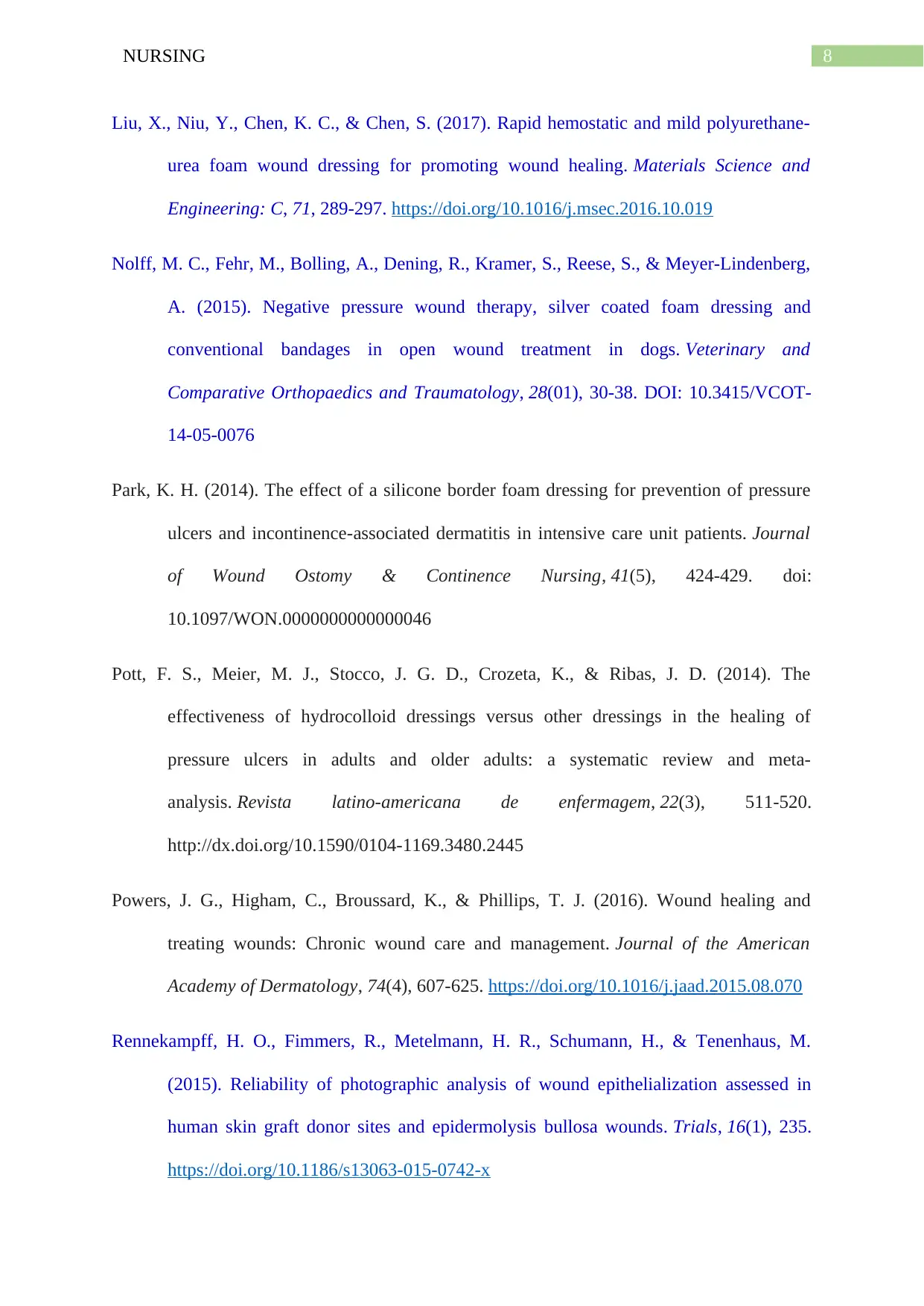
8NURSING
Liu, X., Niu, Y., Chen, K. C., & Chen, S. (2017). Rapid hemostatic and mild polyurethane-
urea foam wound dressing for promoting wound healing. Materials Science and
Engineering: C, 71, 289-297. https://doi.org/10.1016/j.msec.2016.10.019
Nolff, M. C., Fehr, M., Bolling, A., Dening, R., Kramer, S., Reese, S., & Meyer-Lindenberg,
A. (2015). Negative pressure wound therapy, silver coated foam dressing and
conventional bandages in open wound treatment in dogs. Veterinary and
Comparative Orthopaedics and Traumatology, 28(01), 30-38. DOI: 10.3415/VCOT-
14-05-0076
Park, K. H. (2014). The effect of a silicone border foam dressing for prevention of pressure
ulcers and incontinence-associated dermatitis in intensive care unit patients. Journal
of Wound Ostomy & Continence Nursing, 41(5), 424-429. doi:
10.1097/WON.0000000000000046
Pott, F. S., Meier, M. J., Stocco, J. G. D., Crozeta, K., & Ribas, J. D. (2014). The
effectiveness of hydrocolloid dressings versus other dressings in the healing of
pressure ulcers in adults and older adults: a systematic review and meta-
analysis. Revista latino-americana de enfermagem, 22(3), 511-520.
http://dx.doi.org/10.1590/0104-1169.3480.2445
Powers, J. G., Higham, C., Broussard, K., & Phillips, T. J. (2016). Wound healing and
treating wounds: Chronic wound care and management. Journal of the American
Academy of Dermatology, 74(4), 607-625. https://doi.org/10.1016/j.jaad.2015.08.070
Rennekampff, H. O., Fimmers, R., Metelmann, H. R., Schumann, H., & Tenenhaus, M.
(2015). Reliability of photographic analysis of wound epithelialization assessed in
human skin graft donor sites and epidermolysis bullosa wounds. Trials, 16(1), 235.
https://doi.org/10.1186/s13063-015-0742-x
Liu, X., Niu, Y., Chen, K. C., & Chen, S. (2017). Rapid hemostatic and mild polyurethane-
urea foam wound dressing for promoting wound healing. Materials Science and
Engineering: C, 71, 289-297. https://doi.org/10.1016/j.msec.2016.10.019
Nolff, M. C., Fehr, M., Bolling, A., Dening, R., Kramer, S., Reese, S., & Meyer-Lindenberg,
A. (2015). Negative pressure wound therapy, silver coated foam dressing and
conventional bandages in open wound treatment in dogs. Veterinary and
Comparative Orthopaedics and Traumatology, 28(01), 30-38. DOI: 10.3415/VCOT-
14-05-0076
Park, K. H. (2014). The effect of a silicone border foam dressing for prevention of pressure
ulcers and incontinence-associated dermatitis in intensive care unit patients. Journal
of Wound Ostomy & Continence Nursing, 41(5), 424-429. doi:
10.1097/WON.0000000000000046
Pott, F. S., Meier, M. J., Stocco, J. G. D., Crozeta, K., & Ribas, J. D. (2014). The
effectiveness of hydrocolloid dressings versus other dressings in the healing of
pressure ulcers in adults and older adults: a systematic review and meta-
analysis. Revista latino-americana de enfermagem, 22(3), 511-520.
http://dx.doi.org/10.1590/0104-1169.3480.2445
Powers, J. G., Higham, C., Broussard, K., & Phillips, T. J. (2016). Wound healing and
treating wounds: Chronic wound care and management. Journal of the American
Academy of Dermatology, 74(4), 607-625. https://doi.org/10.1016/j.jaad.2015.08.070
Rennekampff, H. O., Fimmers, R., Metelmann, H. R., Schumann, H., & Tenenhaus, M.
(2015). Reliability of photographic analysis of wound epithelialization assessed in
human skin graft donor sites and epidermolysis bullosa wounds. Trials, 16(1), 235.
https://doi.org/10.1186/s13063-015-0742-x

9NURSING
Senet, P., Bause, R., Jørgensen, B., & Fogh, K. (2014). Clinical efficacy of a silver‐releasing
foam dressing in venous leg ulcer healing: a randomised controlled trial. International
wound journal, 11(6), 649-655. https://doi.org/10.1111/iwj.12022
Senet, P., Bause, R., Jørgensen, B., & Fogh, K. (2014). Clinical efficacy of a silver‐releasing
foam dressing in venous leg ulcer healing: a randomised controlled trial. International
wound journal, 11(6), 649-655. https://doi.org/10.1111/iwj.12022
1 out of 10
Related Documents
Your All-in-One AI-Powered Toolkit for Academic Success.
+13062052269
info@desklib.com
Available 24*7 on WhatsApp / Email
![[object Object]](/_next/static/media/star-bottom.7253800d.svg)
Unlock your academic potential
© 2024 | Zucol Services PVT LTD | All rights reserved.




